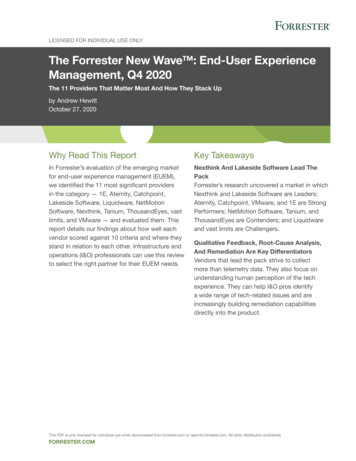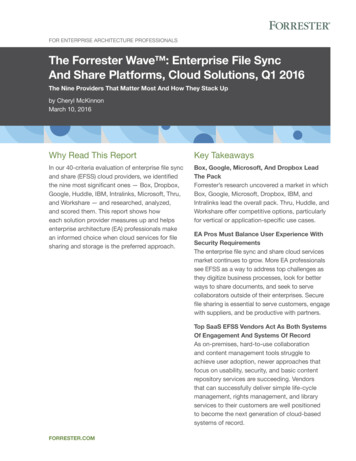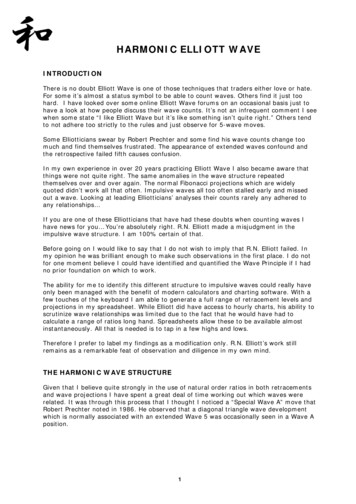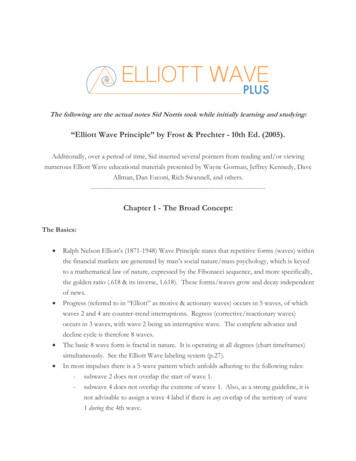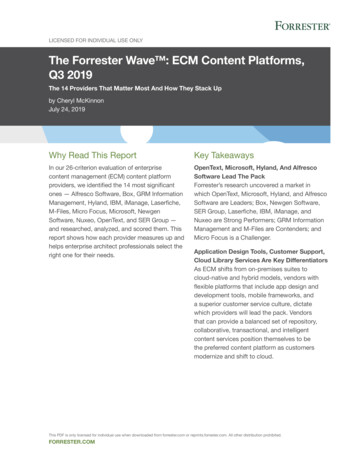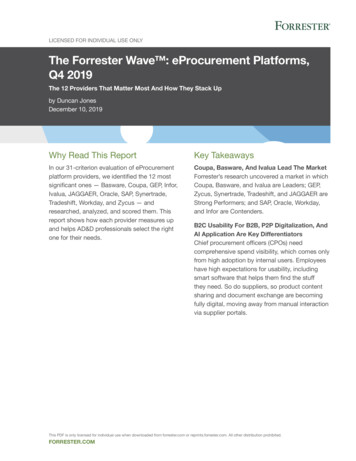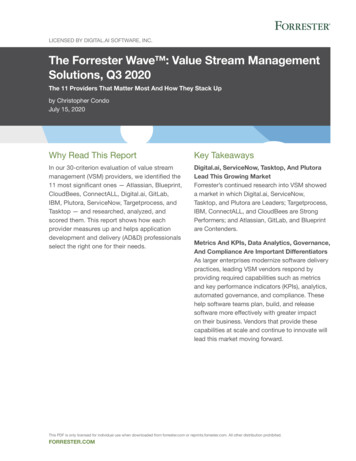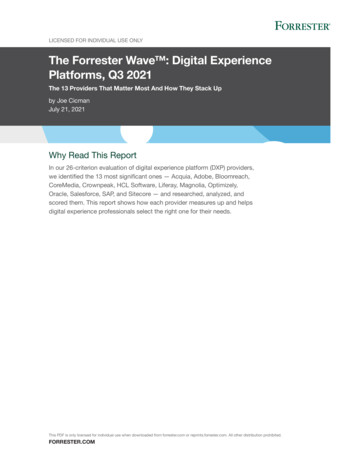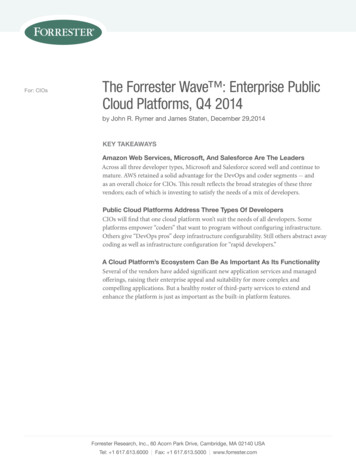
Transcription
For: CIOsThe Forrester Wave : Enterprise PublicCloud Platforms, Q4 2014by John R. Rymer and James Staten, December 29,2014Key TakeawaysAmazon Web Services, Microsoft, And Salesforce Are The LeadersAcross all three developer types, Microsoft and Salesforce scored well and continue tomature. AWS retained a solid advantage for the DevOps and coder segments -- andas an overall choice for CIOs. This result reflects the broad strategies of these threevendors; each of which is investing to satisfy the needs of a mix of developers.Public Cloud Platforms Address Three Types Of DevelopersCIOs will find that one cloud platform won’t suit the needs of all developers. Someplatforms empower “coders” that want to program without configuring infrastructure.Others give “DevOps pros” deep infrastructure configurability. Still others abstract awaycoding as well as infrastructure configuration for “rapid developers.”A Cloud Platform’s Ecosystem Can Be As Important As Its FunctionalitySeveral of the vendors have added significant new application services and managedofferings, raising their enterprise appeal and suitability for more complex andcompelling applications. But a healthy roster of third-party services to extend andenhance the platform is just as important as the built-in platform features.Forrester Research, Inc., 60 Acorn Park Drive, Cambridge, MA 02140 USATel: 1 617.613.6000 Fax: 1 617.613.5000 www.forrester.com
For CIOsDecember 29, 2014The Forrester Wave : Enterprise Public Cloud Platforms, Q42014How The 16 Providers That Matter Most Stack Upby John R. Rymer and James Statenwith Peter Burris, Christopher Mines, and Dominique WhittakerWhy Read This ReportPublic cloud application platforms unlock the flexibility, developer-productivity, and economic advantagesof cloud computing. Business technology and technology management professionals use a wide variety ofpublic cloud platforms, and this Forrester Wave evaluates the leading providers of these choices. Publiccloud platforms take several forms, including those providing basic infrastructure-as-a-service up throughthose providing full or partial platform services and tools. Each of these types of platforms is best suitedto a distinct type of application development and delivery (AD&D) pro within your ranks. In Forrester’s19-criteria evaluation of public cloud vendors, we identified the 16 most significant public cloud platformproviders for large enterprises — Acquia, Amazon Web Services (AWS), CenturyLink, Cordys, DimensionData, Engine Yard, GoGrid, Google, IBM, Mendix, Microsoft, MIOsoft, OutSystems, Rackspace, Salesforce,and Verizon. This report details for CIOs how well each vendor fulfills our criteria and is suitable for arange of developers within your organization. Our goal: Help CIOs select public cloud platform partnersthat deliver the best balance of agility and enterprise fit.Table Of ContentsNotes & Resources2 Platforms Are Crucial For EnterpriseAdoption Of Public CloudsDuring July and August 2014, Forrestergathered functional, strategy, and marketpresence information from each of the14 participating vendors. We interviewedtwo reference customers for each vendor,and conducted structured productdemonstrations with Acquia, CenturyLink,Dimension Data, Google, IBM, Mendix,Microsoft, OutSystems, and Salesforce.3 Your Platform Choice Starts With YourDeveloper Segments4 Balance Developer Empowerment AndEnterprise Suitability10 Our Segment-Based Analysis Of PublicCloud Platforms22 CIOs: Adjust The Criteria Weightings ToReflect Your Organization22 Vendor Profiles27 Supplemental MaterialRelated Research DocumentsThe Forrester Wave : Public Cloud PlatformService Providers’ Security, Q4 2014November 17, 2014The Forrester Wave : Enterprise PublicCloud Platforms, Q2 2013June 14, 2013 2014, Forrester Research, Inc. All rights reserved. Unauthorized reproduction is strictly prohibited. Information is based on best availableresources. Opinions reflect judgment at the time and are subject to change. Forrester , Technographics , Forrester Wave, RoleView, TechRadar,and Total Economic Impact are trademarks of Forrester Research, Inc. All other trademarks are the property of their respective companies. Topurchase reprints of this document, please email clientsupport@forrester.com. For additional information, go to www.forrester.com.
For CIOs2The Forrester Wave : Enterprise Public Cloud Platforms, Q4 2014Platforms Are Crucial For Enterprise Adoption Of Public CloudsIn increasing numbers, enterprises are adding public clouds to their technology portfolios. Adoptionof public clouds by enterprises will cross over the 36% mark this year.1As enterprises move to public clouds, selecting the right public cloud platform is a crucial decision.Forrester defines public cloud platforms as:A publicly accessible application-hosting platform for customer-created executables. The servicemust be a standardized IT service offering, at minimum an application runtime platform and/orvirtual infrastructure, delivered in a pay-per-use, self-service way.Within the CIO’s domain, public cloud platforms empower AD&D pros with frameworks, tools,and consoles that speed creation, deployment, and ongoing updates. Select the right platform andAD&D pros will be highly productive.Public Cloud Platforms Are Evolving To Meet Enterprise NeedsThe popular wisdom that cloud computing comes in three flavors — software-as-a-service (SaaS),infrastructure-as-a-service (IaaS), and platform-as-a-service (PaaS) — no longer describes reality.We find that vendors are blurring the lines between the three cloud-computing categories as theyseek to create public cloud platforms that can satisfy the needs of enterprises and widen their appealto developers (see Figure 1). The four trends we see are: Historical IaaS vendors are embracing abstract development layers. IaaS pioneers, such asAmazon Web Services (AWS) and Rackspace, are building services that deliver the abstractionand hosted middleware benefits often associated with PaaS. AWS’ CloudFormation, ElasticMapReduce, and Cognito are examples of these services.2 We refer to these platforms as “IaaS .” Traditional PaaS vendors are reaching down to the virtual infrastructure. Some PaaSoriginators now offer both highly abstracted platforms and transparency to the underlyingplumbing. Engine Yard, for example, provides both an abstracted interface for developers andthe ability to configure underlying middleware, database, and IaaS resources. Heroku, one ofSalesforce’s cloud platforms, runs on AWS, and the vendor encourages developers to mix AWSand Heroku services. Other past PaaS vendors are now directly in the IaaS business. Two of the leading early PaaSvendors, Microsoft and Google, now have IaaS services and have seen accelerated growth as aresult. In Microsoft’s case, its historical PaaS and newer IaaS are not silos but blended developerexperiences allowing DevOps developers to build components on abstracted middleware andmix them easily with components hosted in virtual machines (VMs).3 2014, Forrester Research, Inc. Reproduction ProhibitedDecember 29,2014
For CIOs3The Forrester Wave : Enterprise Public Cloud Platforms, Q4 2014 SaaS vendors are pushing into platforms with extensibility features. Salesforce’s Force.complatform is the leading example of a product that began life as a set of application extension toolsand is now a public cloud platform used for many applications. Intuit, NetSuite, Workday, Box,and other SaaS vendors are beginning to follow suit, though most do not have complete PaaSofferings that deliver independent value for enterprise AD&Ds today. (For this reason, we chosenot to include any SaaS extensibility platforms except for Force.com in our Forrester Wave.)Figure 1 The Boundaries Between SaaS, PaaS, And IaaS Are BlurringSaaS Fixed application Defined structures Singular purpose UI customizations SaaS extensions Deep customization Integrations Developer services APIsSaaS extensionplatforms118381“IaaS ”PaaS Applicationcontainer(s) Platform, appservices App life-cyclemanagement Development toolsIaaS Virtual infrastructure OS/MW configuration Network and storagedefinitionSource: Forrester Research, Inc. Unauthorized reproduction or distribution prohibited.Your Platform Choice Starts With Your Developer SegmentsAn evolving market with blending product categories makes selecting and adopting a public cloudplatform challenging. The best way to proceed under these circumstances is to key your platformselection to your developers and their needs.The 43 reference customers we interviewed for this research represent a cross-section of theenterprises committing to use public cloud platforms for enterprise applications. Within thesample, we identified three types of developers, each with distinct backgrounds, preferences, andmotivations that strongly influenced the choice(s) of public cloud platforms. The three types ofdevelopers differ mostly in the depth of resource control they need and want (see Figure 2): 2014, Forrester Research, Inc. Reproduction ProhibitedDecember 29,2014
For CIOs4The Forrester Wave : Enterprise Public Cloud Platforms, Q4 2014 Rapid developers want high productivity, not resource details. Rapid devs prefer not to code;coding takes too long. They value graphical, automated tools for creating applications. (In anearlier era, rapid devs adopted fourth-generation programming languages — 4GLs.) Rapiddevs want to deliver major applications in weeks — days if possible. They see public cloudplatforms as a fresh start with the potential to yield massive gains in the quantity, velocity, andquality of application delivery. They rarely desire — and often lack the skills necessary — towrite infrastructure code, and control virtual infrastructure, middleware configuration, andapplication deployment and management. Coders want to program, not manage infrastructure. Coders prefer writing code, butwant to concentrate on perfecting the application and not be bothered with configuring andmaintaining application servers and databases — and certainly not virtual infrastructure. Theysimply want to quickly deploy their applications, gain feedback, and roll-in revisions andnew features. Coders often need to make configuration decisions to get the performance andcapabilities they seek, but rarely want to take on management of the infrastructure configurationif they can avoid it. Thus, coders prefer PaaS and IaaS services that slash deployment time andcomplexity and make deep configuration, deployment, and management choices for them. DevOps pros want configuration control when they need it. The DevOps pro also codes,and needs to configure the platform supporting his or her code.4 DevOps pros often configurethe application server and database, and sometimes want access to VM, network, and storageconfiguration as well. For this reason, DevOps pros can’t get their jobs done only with graphicaltools and other abstractions that impede access to all of the platform’s “tuning knobs.” DevOpspros prefer IaaS, IaaS , and PaaS products that allow deep configuration.AD&D organizations employ all three developer types and, increasingly, a variety of languagesand frameworks. Thus, for many enterprises, the best choice of a public cloud platform will be aplatform (or a portfolio of platforms) that addresses multiple types of developers working withseveral languages and frameworks.Balance Developer Empowerment And Enterprise SuitabilityAfter examining past research, user-need assessments, surveys, and vendor and expert interviews,we developed a comprehensive set of selection criteria and invited 33 vendors to apply forparticipation in our Forrester Wave. Forrester narrowed the list to 16 vendors by focusing onnine platform characteristics that describe the vendors’ enterprise customer base, global scope,and platform breadth (see Figure 3). The selected vendors were: Acquia, Amazon Web Services,CenturyLink, Cordys, Dimension Data, Engine Yard, GoGrid, Google, IBM, Mendix, Microsoft,MIOsoft, OutSystems, Rackspace, Salesforce, and Verizon. 2014, Forrester Research, Inc. Reproduction ProhibitedDecember 29,2014
For CIOs5The Forrester Wave : Enterprise Public Cloud Platforms, Q4 2014Our analysis excluded many vendors, including Appian, Apprenda, AT&T, Caspio, Informatica,Intuit, Joyent, Oracle, OrangeScape Technologies, Pegasystems, SAP, Servoy, Software AG(LongJump), Tibco, VMware, and WorkXpress. Some didn’t have qualifying products generallyavailable by our deadline or did not offer their platform in both the US and Europe by our deadline.Others focused primarily on supplying enterprises with “internal cloud” software. Still others werenot available as public cloud services or didn’t have a strong focus on global enterprises.We evaluated the vendors’ cloud platforms in general availability (GA) as of June 30, 2014 using 19criteria based on the requirements from our AD&D clients. We also incorporated several criteriacritical to chief information security officers (CISO), such as security controls, plus compliance andaudits. Additional criteria address the concerns of the infrastructure and operations professionals(breadth of infrastructure and storage options, hybrid deployment types, depth of identity andaccess, and network configuration controls). The criteria fall into three groupings: Fifteen criteria assess the current offering. The 15 criteria measure a mix of developerenablement and enterprise readiness features. The criteria start with the developer autonomyprovided by self-service portals, RESTful application programming interfaces (APIs), andconfiguration tools. The degree of platform abstraction and access to underlying infrastructurefor custom configuration is next. We use a vendor’s support for languages, application servicesand transaction features, development and test facilities, and deployment options as a measureof how rapidly and effectively a given developer can be productive on the platform. We evaluateeach vendor’s security and reliability controls and its audits and certifications to determinereadiness to meet corporate governance requirements. Finally, we examine the breadth ofinfrastructure provided, deployment options available, and monitoring and scaling capabilities. Two criteria assess vendor strategy. We examine two key factors that can affect the immediateand long-term viability and applicability of a cloud platform to enterprise-level requirements.We look at product strategy for unique vision, differentiating value, fit with enterprise needs,and execution of road maps. Second, we examine the vendor’s partner ecosystem to determinehow broadly third-party vendors of development tools, database and other platform services,and management tools support its platform. A large ecosystem dramatically improves thecustomer’s ability to deliver applications, find support for key components, supplement staffwith consultants, and empower management of its cloud applications. Two criteria assess each vendor’s market presence. We examine the size of the customer basefor the cloud platform, as well as its current revenues and revenue growth rate. Many enterprisesfavor platforms used by other enterprises or cutting-edge companies, so size and makeup of thecustomer base is a key criteria. Similarly, enterprises need to know whether a cloud platform isfinancially viable and gaining adoption. 2014, Forrester Research, Inc. Reproduction ProhibitedDecember 29,2014
For CIOs6The Forrester Wave : Enterprise Public Cloud Platforms, Q4 2014Figure 2 The Three Types Of Cloud Developers118381DevOps proCoderRapid developer Coder Must configureplatform services andvirtual resources Usually codes locally,deploys own stack tocloud Coder Avoids platform andvirtual resourceconfiguration Usually codes locally,deploys own stack tocloud App developer Shuns platform andvirtual resourceconfiguration Develops in thecloud platformSource: Forrester Research, Inc. Unauthorized reproduction or distribution prohibited. 2014, Forrester Research, Inc. Reproduction ProhibitedDecember 29,2014
For CIOs7The Forrester Wave : Enterprise Public Cloud Platforms, Q4 2014Figure 3 Evaluated Vendors: Public Cloud Platform Information And Selection CriteriaVendor nameProduct nameAcquiaAcquia CloudAmazon Web ServicesAmazon Elastic Compute Cloud (EC2)Version evaluatedAuto ScalingAmazon RedShiftAmazon Elastic Map ReduceAmazon KinesisAmazon CloudTrailAmazon Elastic BeanstalkElastic Load BalancingAmazon CloudFrontAmazon Relational Database Service (RDS)Amazon DynamoDBAmazon ElastiCacheAWS Identity and Access Management (IAM)Amazon Virtual Private Cloud (VPC)Amazon Simple Storage Service (S3)Amazon GlacierAmazon Elastic Block Store (EBS)Amazon CloudWatchAWS Elastic BeanstalkAWS CloudFormerAmazon CloudSearchAmazon Simple Workflow Service (SWF)Amazon Simple Queue Service (SQS)Amazon Simple Notification Service (SNS)Source: Forrester Research, Inc. Unauthorized reproduction or distribution prohibited. 2014, Forrester Research, Inc. Reproduction ProhibitedDecember 29,2014
For CIOs8The Forrester Wave : Enterprise Public Cloud Platforms, Q4 2014Figure 3 Evaluated Vendors: Public Cloud Platform Information And Selection Criteria (Cont.)Vendor nameProduct nameAmazon Web ServicesAmazon Simple Email Service (SES)Version evaluatedAWS Storage GatewayAWS Import/ExportAWS Direct ConnectCenturyLinkCenturyLink CloudCordysCordys Process Factory (CPF)Cordys Business Operations Platform (BOP)4.2Cordys Cloud Provisioning (CCP)4.5Dimension DataPublic CaaSEngine YardEngine Yard CloudEngine Yard ManagedGoGridGoGrid Cloud HostingGoGrid Managed ServicesGoogleGoogle App EngineGoogle Compute EngineGoogle Cloud StorageGoogle Cloud DatastoreGoogle Cloud SQLBigQueryIBMIBM BluemixIBM SoftLayerMendixMendix App PlatformMicrosoftMicrosoft AzureVirtual MachinesCloud ServicesSource: Forrester Research, Inc. Unauthorized reproduction or distribution prohibited. 2014, Forrester Research, Inc. Reproduction ProhibitedDecember 29,2014
For CIOs9The Forrester Wave : Enterprise Public Cloud Platforms, Q4 2014Figure 3 Evaluated Vendors: Public Cloud Platform Information And Selection Criteria (Cont.)Vendor nameProduct nameMicrosoftWeb sitesVersion evaluatedMobile ServicesStorageSQL DatabaseSQL ReportingBackupHDInsightMedia ServicesActive DirectoryService BusCachingBizTalk ServicesVirtual NetworkTraffic ManagerExpressRouteNotification HubsAutoscaleAzure Resource ManagerAzure SchedulerMIOsoftMIOedgeOutSystemsOutSystems PlatformRackspaceRackspace CloudSource: Forrester Research, Inc. Unauthorized reproduction or distribution prohibited. 2014, Forrester Research, Inc. Reproduction ProhibitedDecember 29,2014
For CIOs10The Forrester Wave : Enterprise Public Cloud Platforms, Q4 2014Figure 3 Evaluated Vendors: Public Cloud Platform Information And Selection Criteria (Cont.)Vendor nameProduct nameSalesforceForce.comVersion evaluatedSalesforce1 PlatformHerokuHeroku ConnectVerizonVerizon Enterprise CloudVerizon CloudNote: See Appendix for vendor inclusion criteria.Source: Forrester Research, Inc. Unauthorized reproduction or distribution prohibited.Our Segment-Based Analysis Of Public Cloud PlatformsOur research clearly shows that public cloud platforms are not a one-size-fits-all market. Rather,products are designed to satisfy the needs of one — sometimes two — developer segments. Ourevaluation examines the 16 public cloud platforms using the requirements of our three developercategories plus the requirements of CIO leaders whose development teams include the three typesbelow. Here is how we adjusted the weightings to reflect the needs of each group: For CIOs, our weightings emphasize security and reporting. Our CIO analysis makes twoassumptions. First, CIOs oversee teams incorporating all three types of developers. Thus, allvendors are of interest. Second, CIOs (via their I&O and security leaders) know which cloudplatforms can best meet the compliance and auditing needs of the range of business technologyservices and solutions. Thus, in this analysis, we gave added weight to security controls andreporting and monitoring features (see Figure 4). This analysis includes all 16 vendors. For rapid developers, we gave extra weight to extreme abstraction. For rapid devs, wechose weightings that put higher value on self-service, abstraction features (automatic scaling,reliability solution) and the completeness of the development, testing, and deployment services.Because rapid developers don’t want deep configuration control, we inverted our scale forreliability functions (so that a high score reflects high automation of reliability) (see Figure 5).We included only Acquia, Cordys, Mendix, MIOsoft, OutSystems, and Salesforce in this analysis,as these vendors directly target rapid devs and in our analysis proved to be the only platformsthat directly meet their needs. Coder weighting favored dev tools and infrastructure abstraction. For coders, we choseweightings that emphasize language and framework support, platform (as opposed toinfrastructure) configuration control, and development, test, and deployment tools. Similar to 2014, Forrester Research, Inc. Reproduction ProhibitedDecember 29,2014
For CIOs11The Forrester Wave : Enterprise Public Cloud Platforms, Q4 2014rapid devs, coders want their cloud platform to abstract away the complexity of operationaltasks such as high availability assurance, while control over reliability functions is valued morethan rapid developers. As such, we inverted these criteria but reduced its weighting to reflectthis client’s needs (see Figure 6). We included all vendors in this analysis except those that donot support coding as a development method and do not provide direct access to platform and/or virtual infrastructure configuration (Mendix, MIOsoft, and OutSystems), as well as vendorsthat provide no native development tools other than their APIs (CenturyLink, Dimension Data,GoGrid, and Verizon). DevOps pros weighting favored deep configuration controls. For DevOps pros, we weighted moreheavily criteria that deliver autonomous control over the infrastructure, platform and reliabilityconfiguration, and monitoring and reporting features that are so key to maintenance and operationaloptimizations (see Figure 7). We included all of the vendors in this analysis except those that don’tprovide control over these resources (Acquia, Mendix, MIOsoft, Salesforce, and OutSystems).Figure 4 Forrester Wave : Enterprise Public Cloud Platforms For CIOs, Q4 ongAmazon Web space*(Q2 2013)CurrentofferingCordys*(Q2 2013)SalesforceGo to Forrester.com todownload the ForresterWave tool for moredetailed productevaluations, featurecomparisons, andcustomizable rankings.IBMAcquiaEngine YardCenturyLinkDimension DataGoGridVerizonMarket presenceQ4 2014 Participating vendorWeakQ4 2014 Non-participating vendorWeakStrategyStrong*[Vendor] chose not to participate in this Wave update, but its developments since our last analysis aren’tsubstantial enough to change its position in our market view.Source: Forrester Research, Inc. Unauthorized reproduction or distribution prohibited. 2014, Forrester Research, Inc. Reproduction ProhibitedDecember 29,2014
For CIOs12The Forrester Wave : Enterprise Public Cloud Platforms, Q4 2014Forrester’sWeightingAcquiaAmazon Web ServicesCenturyLinkCordysDimension DataEngine YardGoGridGoogleFigure 4 Forrester Wave : Enterprise Public Cloud Platforms For CIOs, Q4 ‘14 (Cont.)CURRENT OFFERINGSelf-service controlPlatform configuration optionsMonitoring and policy featuresPrivate and hybrid cloud options(VPC to on-premises total isolation)Breadth of storage optionsAudits and certificationsTransaction featuresBreadth of platform and applicationservicesLanguages supportedInfrastructure abstraction featuresApplication deployment servicesSecurity controlsDevelopment and testing toolsReliability functionsAutoscaling 3.001.00STRATEGYProduct strategyPartner 003.003.003.00MARKET PRESENCENumber of customersRevenue and growth 4.002.00All scores are based on a scale of 0 (weak) to 5 (strong).Source: Forrester Research, Inc. Unauthorized reproduction or distribution prohibited. 2014, Forrester Research, Inc. Reproduction ProhibitedDecember 29,2014
For CIOs13The Forrester Wave : Enterprise Public Cloud Platforms, Q4 tOutSystemsRackspaceSalesforceVerizonFigure 4 Forrester Wave : Enterprise Public Cloud Platforms For CIOs, Q4 ‘14 (Cont.)CURRENT OFFERINGSelf-service controlPlatform configuration optionsMonitoring and policy featuresPrivate and hybrid cloud options(VPC to on-premises total isolation)Breadth of storage optionsAudits and certificationsTransaction featuresBreadth of platform and applicationservicesLanguages supportedInfrastructure abstraction featuresApplication deployment servicesSecurity controlsDevelopment and testing toolsReliability functionsAutoscaling 1.001.00STRATEGYProduct strategyPartner 003.003.003.00MARKET PRESENCENumber of customersRevenue and growth 2.001.00All scores are based on a scale of 0 (weak) to 5 (strong).Source: Forrester Research, Inc. Unauthorized reproduction or distribution prohibited. 2014, Forrester Research, Inc. Reproduction ProhibitedDecember 29,2014
For CIOs14The Forrester Wave : Enterprise Public Cloud Platforms, Q4 2014Figure 5 Forrester Wave : Enterprise Public Cloud Platforms For Rapid Developers, Q4 ongMIOsoftSalesforceCordys*(Q2 2013)MendixOutSystemsAcquiaGo to Forrester.com todownload the ForresterWave tool for moredetailed productevaluations, featurecomparisons, andcustomizable rankings.CurrentofferingMarket presenceQ4 2014 Participating vendorWeakQ4 2014 Non-participating vendorWeakStrategyStrong*[Vendor] chose not to participate in this Wave update, but its developments since our last analysis aren’tsubstantial enough to change its position in our market view.Source: Forrester Research, Inc. Unauthorized reproduction or distribution prohibited. 2014, Forrester Research, Inc. Reproduction ProhibitedDecember 29,2014
For CIOs15The Forrester Wave : Enterprise Public Cloud Platforms, Q4 tOutSystemsSalesforceFigure 5 Forrester Wave : Enterprise Public Cloud Platforms For Rapid Developers, Q4 ‘14 (Cont.)CURRENT OFFERINGSelf-service controlPlatform configuration optionsMonitoring and policy featuresPrivate and hybrid cloud options(VPC to on-premises total isolation)Breadth of storage optionsAudits and certificationsTransaction featuresBreadth of platform and applicationservicesLanguages supportedInfrastructure abstraction featuresApplication deployment servicesSecurity controlsDevelopment and testing toolsReliability functionsAutoscaling .005.005.003.004.005.002.001.00STRATEGYProduct strategyPartner 2.002.503.001.004.005.001.004.755.004.00MARKET PRESENCENumber of customersRevenue and growth 751.000.002.253.000.004.255.002.00All scores are based on a scale of 0 (weak) to 5 (strong).Source: Forrester Research, Inc. Unauthorized reproduction or distribution prohibited. 2014, Forrester Research, Inc. Reproduction ProhibitedDecember 29,2014
For CIOs16The Forrester Wave : Enterprise Public Cloud Platforms, Q4 2014Figure 6 Forrester Wave : Enterprise Public Cloud Platforms For Coders, Q4 ongAmazon Web ServicesMicrosoftSalesforceGoogleIBMGo to Forrester.com todownload the ForresterWave tool for moredetailed productevaluations, featurecomparisons, andcustomizable rankings.CurrentofferingCordys*(Q2 2013)Engine YardAcquiaMarket presenceQ4 2014 Participating vendorQ4 2014 Non-participating vendorWeakWeakStrategyStrong*[Vendor] chose not to participate in this Wave updat
The Forrester Wave : Public Cloud Platform service Providers' security, Q4 2014 November 17, 2014 The Forrester Wave : Enterprise Public Cloud Platforms, Q2 2013 June 14, 2013 The Forrester wave : enterprise Public Cloud Platforms, Q4 2014 How The 16 Providers That Matter Most stack Up by John r. rymer and James staten



